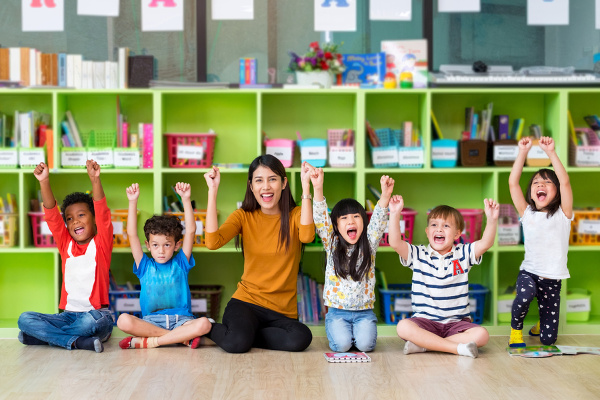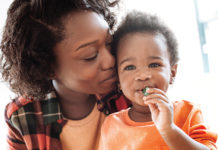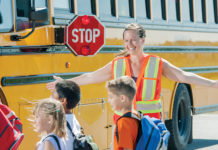
Whether you’re a preschool, kindergarten, elementary, or middle school teacher, one thing is for certain: you need a classroom behavior management system that works. Learn the difference between positive and negative reinforcement, how to use positive reinforcement in the classroom, as well as our favorite reinforcement systems to encourage appropriate behavior in your students below!
Positive vs. Negative Reinforcement
Reinforcement is an effective technique teachers can use to encourage the behaviors they want to see in their students.
There are 2 different types of reinforcement:
Positive reinforcement involves rewarding a child with something pleasant as a means of reinforcing a particular behavior. For example, if a child does well on a test, a teacher may place a sticker on the graded test along with an encouraging note to reinforce the hard work the child put into studying.
Negative reinforcement occurs when something undesirable is removed as a means to reinforce a certain behavior. For example, if a teacher is starting a new lesson and her students are being loud and rowdy, he/she may inform the class that if they are quiet and listen to the lesson without interruption, he/she won’t assign homework that night.
Many people confuse negative reinforcement with punishment, but the 2 are very different. With negative reinforcement, something is taken away in an effort to encourage a specific behavior, while punishment involves taking something away to decrease/weaken behavior.
How to Use Positive Reinforcement in the Classroom
Both positive and negative reinforcement are effective ways of strengthening desirable behavior in children when used correctly. Negative reinforcement tends to be effective in the short-term, however research tends to suggest that positive reinforcement is a better long-term strategy for younger children.
If you want to know how to use positive reinforcement in the classroom, here are 6 things to consider:
1. Be clear and consistent
If you want to know how to use positive reinforcement in the classroom, one of the first things you want to do is set clear guidelines for your students, and commit to following through with them. Take the time to review your expectations with your students when needed, and remember that the key to good behavior is consistency.
2. Make sure the reinforcement is immediate
In order for any type of reinforcement to be effective, it needs to be implemented immediately after the behavior you are trying to change. So, in the case of positive reinforcement, the reward must be provided as soon as the desirable behavior occurs.
3. Never take rewards away!
If a sticker, prize, token, or coupon is earned, it is something to be proud of. Do not punish a student by discounting something he/she worked hard to achieve in the past due to his/her poor behavior in the present.
4. Choose something that’s motivating
When choosing a reinforcement system, you want to make sure it will be motivating to your students and that you can sustain it over time. You also need to be careful and pick something everyone can enjoy, and that will be well-received by your students’ parents. Sweets and desserts are an example of a reinforcement not all children can enjoy due to food sensitivities and allergies, diabetes, and parental rules around sugar intake.
5. Make sure it’s attainable
Another important but sometimes overlooked tip for those who want to know how to use positive reinforcement in the classroom is to ensure every child can legitimately meet your expectations. For example, if you thinking of creating a class reward system whereby every student has to read 4 books within a month to earn a class pizza party, ask yourself how realistic this is. If you have a couple of struggling readers in your class, 4 books might be too big a stretch for them. While you want to motivate and challenge your class, these students may feel anxious and discouraged due to fear of failure, and their peers may place undue pressure on them and retaliate if the reward isn’t earned.
6. Find ways to positively reinforce every child
My final tip for those who want to know how to use positive reinforcement in the classroom is to make sure you reward everyone. While there will be certain children in your classroom who routinely exhibit the behaviors you are trying to reinforce, and others who seem to go out of their way to push your buttons, it’s important that you find a way to positively reinforce the behavior of each child over time in order for your reinforcement system to be successful. If the same students receive praise and/or rewards over and over again, the others will eventually feel there is no point trying. Keep in mind that the children who act out the most are typically the ones who need the most love, so dig deep and find a way to call attention to the things they do right every now and then.
9 Classroom Reinforcement Systems that Work
There are so many ways you can incorporate positive reinforcement into a classroom setting, and you can make them as simple or elaborate as you see fit. As long as the reinforcement is immediate, motivating, and attainable, it will serve as an effective tool in encouraging and guiding your students’ behavior. If you’re trying to figure out how to use positive reinforcement in the classroom, here are 9 classroom reinforcement systems to consider.
1. Verbal praise
Contrary to popular belief, positive reinforcement doesn’t need to be complicated. Taking the time to verbally acknowledge what a child did correctly through positive language can go a long way in motivating him/her to repeat the behavior again.
2. Stickers and written praise
My daughter always gets a sticker in her homework book when she completes her assignments correctly and on time, and her teacher usually writes something encouraging like, ‘keep up the good work!’ or ‘this is so impressive!’ every couple of weeks. It takes very little time for her teacher to do these things, but they really motivate her to work hard each week.
3. Special privileges
Awarding special privileges to students who engage in behaviors you’re trying to reinforce is another simple yet effective tool you can use in the classroom. For example, you might let them choose where they sit for the day, make them the leader of the class line at recess, or ask them to be your special assistant for the day. This is a great way to publicly recognize their efforts in front of the rest of the class, which can be extra motivating, while also encouraging other students to follow their lead.
4. Send a positive note home
If you want to know how to use positive reinforcement in the classroom, another fabulous idea is to send a letter to the child’s parents/caregivers detailing their good behavior. Just remember that the reinforcement has to be immediate in order to be effective. A simple way to do this is to create a blank template, print off multiple copies, and fill the letter out in the moment so the student can put it in his/her bag to take home. This will not only reward them in the classroom, but it will provide a chance for additional praise and recognition at home as well, which can be even more rewarding!
5. Prize box
Depending on how big your classroom is, and the age and needs of the children you are teaching, a small prize box filled with trinkets from the dollar store is another great way to reinforce positive behavior. This can be extremely motivating in a special education classroom, or you can use it when you’re teaching a particularly difficult lesson, or at a time of year when your students are really struggling to focus and concentrate (i.e. before the winter or summer holidays, when the weather precludes you from going outside for recess, etc.).
6. Token economy
If you’ve been researching tips on how to use positive reinforcement in the classroom, you’ve probably come across the idea of enforcing a token economy. The idea is pretty simple – the teacher rewards tokens when a student engages in desirable behavior, and the student can trade the tokens in at a later time in exchange for a reward – and I love that it allows you to create multiple rewards to ensure there is an option each student will find motivating.
7. Behavior punch cards
This is a variation on the idea above, but I still wanted to include it as I like that it it’s a more hands-on reward system for students. There are tons of behavior punch card templates you can find online (I love this one on Teachers Pay Teachers), and all you have to do is print off a card for each student to keep in his/her desk. Each time a student engages in a behavior you’re trying to reinforce, you can acknowledge their behavior in front of the class and allow them to punch their own card using a hole punch kept on your desk or at the front of the classroom. By calling them out in front of their peers, it not only reinforces their behavior further, but it also motivates the other students.
8. Behavior coupons
If you’re interested in creating some sort of token economy, but want to make it more creative and meaningful, rewarding your students with behavior coupons is another great option to consider. This is a great reinforcement system for younger kids as the reward is immediate.
9. Brag bracelets
I really love reinforcement systems that involve both teachers and parents, so my last idea for teachers who want to know how to use positive reinforcement in the classroom is to print off a set of brag bracelets on brightly colored printer paper. It’s a great way to call your students out in front of their peers, and they will love showing mom and dad their achievement at the end of the day!
If you’re trying to figure out how to use positive reinforcement in the classroom, I hope these tips and ideas prove useful to you! Be careful to reinforce desirable behaviors immediately, and ensure the rewards are both motivating and attainable to all of your students. Be clear and consistent, and make sure you find a way to positively reinforce ALL of your students to keep their motivation up!













